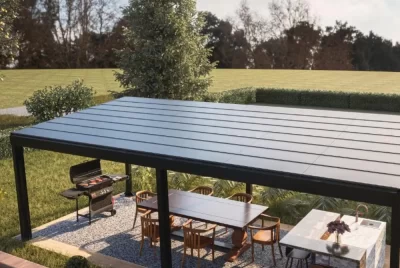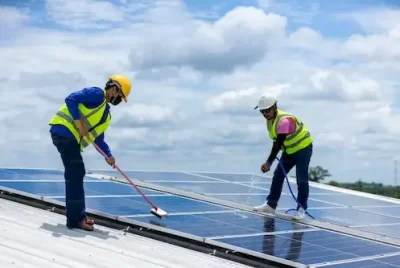How to Choose Solar Panels: Which Ones are Right for You?
We may earn a commission for purchases made using our links. See our disclosure to learn more.
How to choose solar panels for your specific needs? Which ones are right for you? With numerous types of solar panels available in the market, it can be overwhelming to determine which ones are the best fit for you. In this article, I will explore different types of solar panels and provide helpful suggestions to assist you in making an informed decision.
Understanding Solar Panels
Solar panels are devices that harness the power of sunlight and convert it into usable electricity. They are made up of photovoltaic cells that absorb sunlight and generate direct current (DC), which is then converted into alternating current (AC) through an inverter for household or commercial use.
What are solar panels?
Solar panels are composed of multiple solar cells, typically made of silicon, which have the ability to convert sunlight into electricity. These panels come in various sizes and configurations to cater to different energy requirements.
How do solar panels work?
Solar panels work by utilizing the photovoltaic effect. When sunlight strikes the solar cells, the photons in the light knock electrons loose from their atoms, generating an electric current. This current is then captured and converted into usable electricity.
Types of Solar Panels
There are several types of solar panels available in the market, each with its own advantages and limitations. Let’s explore the most common types:
Monocrystalline Panels
Monocrystalline panels are made from a single crystal structure, typically silicon. They are known for their high efficiency, sleek appearance, and excellent performance in low-light conditions. However, they tend to be more expensive than other options.
Polycrystalline Panels
Polycrystalline panels are made from multiple silicon crystals. They are less expensive to produce and offer a good balance between efficiency and cost-effectiveness. While their efficiency is slightly lower than monocrystalline panels, they still provide a reliable source of solar power.
Thin-Film Panels
Thin-film panels are made by depositing a thin layer of photovoltaic material onto a substrate. They are lightweight, flexible, and suitable for certain applications where rigid panels are not ideal. However, they have lower efficiency compared to crystalline panels and require more space.
Bifacial Panels
Bifacial panels have the ability to generate electricity from both sides by capturing sunlight from the front and reflected light from the rear. This design maximizes energy production and can be advantageous in certain installations. Bifacial panels are typically made of crystalline silicon and offer increased energy yield, although they may come at a higher cost.
Concentrated Solar Power
Concentrated solar power (CSP) systems use mirrors or lenses to concentrate sunlight onto a small area, generating heat that can be used to produce electricity. CSP is commonly used in large-scale power plants and has the advantage of providing power even when the sun is not directly overhead. However, CSP installations require a significant amount of space and are more suitable for utility-scale applications.
Building-Integrated Panels
Building-integrated photovoltaics (BIPV) are solar panels that are incorporated directly into the design of a building, replacing traditional building materials. BIPV systems offer both energy generation and architectural functionality, blending seamlessly into the structure. These panels can be integrated into roofs, facades, or even windows, providing a visually appealing and efficient solution.
Solar Tiles
Solar tiles, also known as solar shingles, are designed to resemble traditional roofing materials while generating electricity. They are an attractive option for homeowners who value aesthetics and want their solar panels to blend in with the rest of the roof. Solar tiles are typically more expensive than traditional solar panels but offer a discreet and integrated solution.
Comparing Different Types
When choosing the right solar panel for your needs, it’s essential to consider several factors and compare different types based on their:
Efficiency
The efficiency of a solar panel refers to its ability to convert sunlight into electricity. Higher-efficiency panels generate more power from the same amount of sunlight. Monocrystalline panels generally have the highest efficiency, followed by polycrystalline, thin-film, and other types.
Cost
The cost of solar panels can vary depending on the type and brand. Monocrystalline panels are usually more expensive, while polycrystalline and thin-film panels offer a more cost-effective option. It’s important to weigh the upfront cost against long-term energy savings.
Space Requirement
Different solar panels have varying space requirements, and this is an important consideration, especially for installations with limited space. Monocrystalline panels tend to be more space-efficient, while thin-film panels require more surface area to generate the same amount of electricity.
Durability
Solar panels are designed to withstand outdoor conditions, but some types may be more durable than others. Factors such as resistance to harsh weather, temperature fluctuations, and impact resistance should be taken into account, particularly in areas with extreme weather conditions.
Aesthetics
The appearance of solar panels may be a concern for some homeowners. Monocrystalline and polycrystalline panels have a more traditional look, while thin-film panels, BIPV, and solar tiles offer a more integrated and visually appealing option.
Factors to Consider
When selecting the right solar panels for your specific situation, it’s important to consider the following factors:
Energy Needs
Evaluate your energy consumption and determine how much electricity you need to generate through solar power. This will help you determine the capacity and number of panels required for your installation.
Available Space
Assess the available space on your property to determine the size and type of panels that can be accommodated. Consider the orientation and tilt angle of the panels for optimal sunlight exposure.
Budget
Set a budget for your solar panel installation, including the cost of equipment, installation, and any additional components such as inverters and mounting systems. Compare prices and explore financing options to make an informed decision.
Climate Conditions
The climate of your location plays a significant role in the performance and efficiency of solar panels. Consider factors such as average sunlight hours, temperature variations, and potential shading from nearby buildings or trees. Some types of panels may perform better in specific climate conditions.
Choosing the Right Solar Panel
The right solar panel for you will depend on your unique requirements and circumstances. Here are some suggestions based on different applications:
Residential Applications
For homeowners, monocrystalline or polycrystalline panels are often recommended. They offer a good balance between efficiency, cost-effectiveness, and aesthetics. Consider the available roof space and your energy needs to determine the appropriate size and number of panels.
Commercial Applications
Commercial properties typically have larger energy demands. Monocrystalline panels are commonly chosen for their high efficiency and space-saving characteristics. Depending on available space and budget, bifacial panels or BIPV systems can also be considered to maximize energy production while integrating seamlessly into the building design.
Off-Grid Applications
If you are looking to power remote locations or have complete energy independence, thin-film panels and CSP systems may be suitable options. Thin-film panels are lightweight and flexible, making them easier to transport and install in off-grid locations. CSP systems can provide continuous power even during periods of limited sunlight.
Installation and Maintenance
Once you have chosen the right solar panels, it’s important to ensure proper installation and maintenance to optimize their performance and longevity.
Finding a Qualified Installer
Hire a reputable and experienced solar panel installer who is certified and familiar with local regulations. They will ensure that the panels are correctly mounted, connected to the electrical system, and comply with safety standards.
Maintenance Tips
Regular maintenance is essential to keep your solar panels operating efficiently. Here are a few tips:
1. Keep the panels clean: Regularly remove dust, debris, and any accumulated dirt from the panels to maximize sunlight absorption.
2. Check for shading: Monitor for any objects or structures that may cast shadows on the panels and trim surrounding trees if necessary.
3. Inspect for damage: Periodically inspect the panels for any physical damage, such as cracks or loose connections, and have them repaired promptly.
4. Monitor performance: Use monitoring systems or apps to track the energy production of your panels and identify any potential issues.
Conclusion
How to Choose Solar Panels? Exploring the different types of solar panels is crucial in making an informed decision that aligns with your energy needs, budget, and preferences. Consider the efficiency, cost, space requirement, durability, and aesthetics of each type. Additionally, evaluate factors such as your energy needs, available space, budget, and climate conditions to choose the right solar panel for your specific application. Remember to work with a qualified installer and perform regular maintenance to ensure optimal performance and maximize your solar energy generation.
FAQs
1. Are all solar panels the same?
No, solar panels come in various types, such as monocrystalline, polycrystalline, thin-film, bifacial, concentrated solar power, building-integrated panels, and solar tiles. Each type has its own characteristics, efficiency levels, and costs.
2. Which solar panel type is the most efficient?
Monocrystalline panels are generally known for their higher efficiency compared to other types. They can convert a greater percentage of sunlight into electricity.
3. Do solar panels work during cloudy days?
Yes, solar panels can still generate electricity even on cloudy days. While the output may be slightly reduced, they can still harness diffuse sunlight to produce power.
4. How long do solar panels last?
Most solar panels come with warranties ranging from 20 to 25 years, but they can last even longer. With proper maintenance, panels can continue to produce electricity for 30 years or more.
5. Can solar panels be installed on any type of roof?
Solar panels can be installed on various types of roofs, including those made of asphalt shingles, metal, tile, or even flat roofs. However, the installation process and requirements may vary depending on the specific roof material. It’s recommended to consult with a professional installer who can assess your roof’s suitability and provide appropriate mounting solutions.
6. Are there any government incentives or rebates for installing solar panels?
Yes, many countries and regions offer incentives and rebates to encourage the adoption of solar energy. These can include tax credits, grants, feed-in tariffs, or net metering programs. It’s advisable to research local government policies and consult with a solar installer to understand the available incentives and how to take advantage of them.
7. Can I install solar panels myself?
While it’s technically possible to install solar panels yourself, it’s highly recommended to hire a qualified and certified installer. Proper installation involves electrical wiring, system integration, and compliance with safety standards. Professional installers have the expertise and experience to ensure a safe and efficient installation.
8. Can I expand my solar panel system in the future?
In most cases, solar panel systems can be expanded or modified to meet changing energy needs. However, this depends on factors such as the available roof space, electrical capacity, and the compatibility of the existing system with new components. It’s advisable to design a solar panel system with potential future expansions in mind, and consult with an installer to assess the feasibility of expanding your specific setup.
9. How long does it take for solar panels to pay for themselves?
The payback period for solar panels can vary depending on factors such as the cost of installation, energy savings, and available incentives. On average, solar panel systems can pay for themselves within 5 to 10 years. After that, the electricity generated becomes essentially free, leading to long-term savings on utility bills.
10. Are solar panels environmentally friendly?
Yes, solar panels are considered an environmentally friendly source of energy. They produce clean electricity without greenhouse gas emissions, reducing reliance on fossil fuels and mitigating the impact of climate change. Additionally, solar panels have a long lifespan and can be recycled at the end of their operational life, further reducing their environmental impact.
Remember, when considering solar panel options, it’s essential to consult with professionals, conduct thorough research, and evaluate your specific requirements to make an informed decision that suits your energy needs, budget, and environmental goals.




